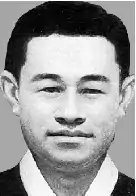Kim Sowol
Kim Sowol (Korean: 김소월; 1902–1934) was a Korean language poet famous for his contributions to early modern poetry.[1] Throughout his life he wrote his poignant poetry in a style reminiscent of traditional Korean folk songs. The most prized example of this style was "Azaleas (진달래꽃)", the title poem of his sole collection of poetry.
Kim Sowol | |
|---|---|
 | |
| Native name | 김소월 |
| Born | Kim Jeong-sik (김정식) September 7, 1902 Kusŏng, North Pyongan Province, Korean Empire |
| Died | December 24, 1934 (aged 32) Kwaksan, Heian-nandō, Japanese Korea (present-day Kwaksan, North Korea) |
| Occupation | Poet |
| Language | Korean |
| Alma mater | Tokyo University |
| Genre | Poetry |
| Notable works | Azalea (진달래꽃) |
| Partner | 홍단실 (Hong Dan-sil) |
| Children | 3 sons |
| Korean name | |
| Hangul | 김소월 |
| Hanja | 金素月 |
| Revised Romanization | Gim So-wol |
| McCune–Reischauer | Kim So-wŏl |
Life
Kim Sowol, whose real name was Kim Jeong-sik (김정식; 金廷湜), was born on September 7, 1902 in Kwaksan, North Pyong'an Province, and died on December 24, 1934.[2] Shortly after he was born his father became insane. This fact must have affected the poet's early life and eventually led to his own premature death. His grandfather taught him classical Chinese and entered him in the famed Osan Middle School (also the alma mater of Baek Seok and Kim Eok) at the age of fifteen. There he became a pupil of Kim Eok (김억; 金憶), who remained his mentor for the rest of his life.
In 1923, Kim went to Japan, but he soon returned to Seoul, where he stayed for the next two years attempting to build a career in literature. However, he then returned to his native region, to the town of Namsai, where he worked as the manager of the local office of the Dong-a Ilbo newspaper. Though his poems continued to appear there, their quality deteriorated and Kim's life descended to habitual drinking and a reported suicide in 1934.[3] In 2007, he was listed by the Korean Poets' Association among the ten most important modern Korean poets.[4]
Work
Kim wrote most of the poems contained in The Azaleas (1925), the only collection of poetry published in his lifetime, while he was still a teenager. After graduating from Paejae High School, he taught for a while in his home town and then went to Japan to study at a college of commerce. While there, he published several poems in Kaebyok and other literary journals. Poems by him continued to appear after his return in such journals as Yongdae until his sudden death.
His teacher Kim Eok published a volume of Sowol's selected poems in 1935. These included his memoir and a critical essay, in which he points out that the poet's true genius lay in composing lines in the rhythm of Korean folk song, thereby making his poems touch directly the hearts of Koreans. The magical charm of Sowol's lines can barely be recaptured fully in English translation, since the spirit of his poetry is conveyed in part through the sound of Korean folk tunes, which imposes an additional challenge on the translation of his work.
Azalea and its alternative meanings
나 보기가 역겨워 |
Even if you leave, |
In the poem a woman is speaking to a lover who may soon leave her. Cultural difference hinders understanding the context and one translator has provided several alternative versions to suit various moods or stylistic choices by way of example.[5] In particular he cites the difficulty in finding a precise equivalent for the emotion being described, although the theme is a standard one both in the Korean literary and folk traditions.
Another commentator addresses the many possible interpretations of what is in essence a simple situation.[6] It has been asked whether Kim Sowol was not being self-indulgent in writing melancholy ditties in the context of the Japanese occupation of Korea. One answer has been that turning his back on experimenting with foreign literary styles, in order to engage with traditional forms in “the purest Korean", and that at a time when the language was under attack from the Japanese and occasionally banned, was a form of cultural resistance. Moreover, some even see the poem as a coded reference to the Japanese presence and an anticipation of their departure.
On the other hand, David McCann believes that “social history or literary biography are not discovered in Azaleas; rather, the social history is found in what others have written about the poem.” In his opinion, the poem should be allowed to stand as itself; the proper business of commentary is to analyse what lies behind the comments of others.
Publication
- Kim, J., 1975, Lost Love: 99 Poems by Sowol Kim, Pan-Korea Book Corporation: Seoul.
- David R McCann, 2007, Azaleas, A book of Poems, by Kim Sowol (Columbia University Publication): New York.
See also
References
- "Kim Sowol" LTI Korea Datasheet available at LTI Korea Library or online at: http://klti.or.kr/ke_04_03_011.do# Archived 2013-09-21 at the Wayback Machine
- 김소월 on Naver
- Lee, Kyung-ho (1996). "Kim, So-Wol". Who's Who in Korean Literature. Seoul: Hollym. p. 265. ISBN 1-56591-066-4.
- Chung, Ah-young (October 15, 2007). "Top Ten Korean Modern Poets Selected". The Korea Times. Retrieved February 12, 2020.
- Brother Anthony:An, Sonjae (1998). "Translating Korean Poetry". Modern Poetry in Translation. 13. Archived from the original on 2015-08-16. Retrieved 2014-07-09.
- David R. McCann, “The Meanings and Significance of So Wŏl's Azaleas”, The Journal of Korean Studies Vol. 6 (1988-89), pp. 211-228
External links
 Works related to 저자:김소월 at Wikisource
Works related to 저자:김소월 at Wikisource Works related to 진달래꽃 at Wikisource
Works related to 진달래꽃 at Wikisource- 김소월 - Encyclopedia of Korean Culture
- 김소월 - Doosan Encyclopedia
- 김소월 - Encyclopædia Britannica online Korea
- Works by Kim Sowol at LibriVox (public domain audiobooks)
